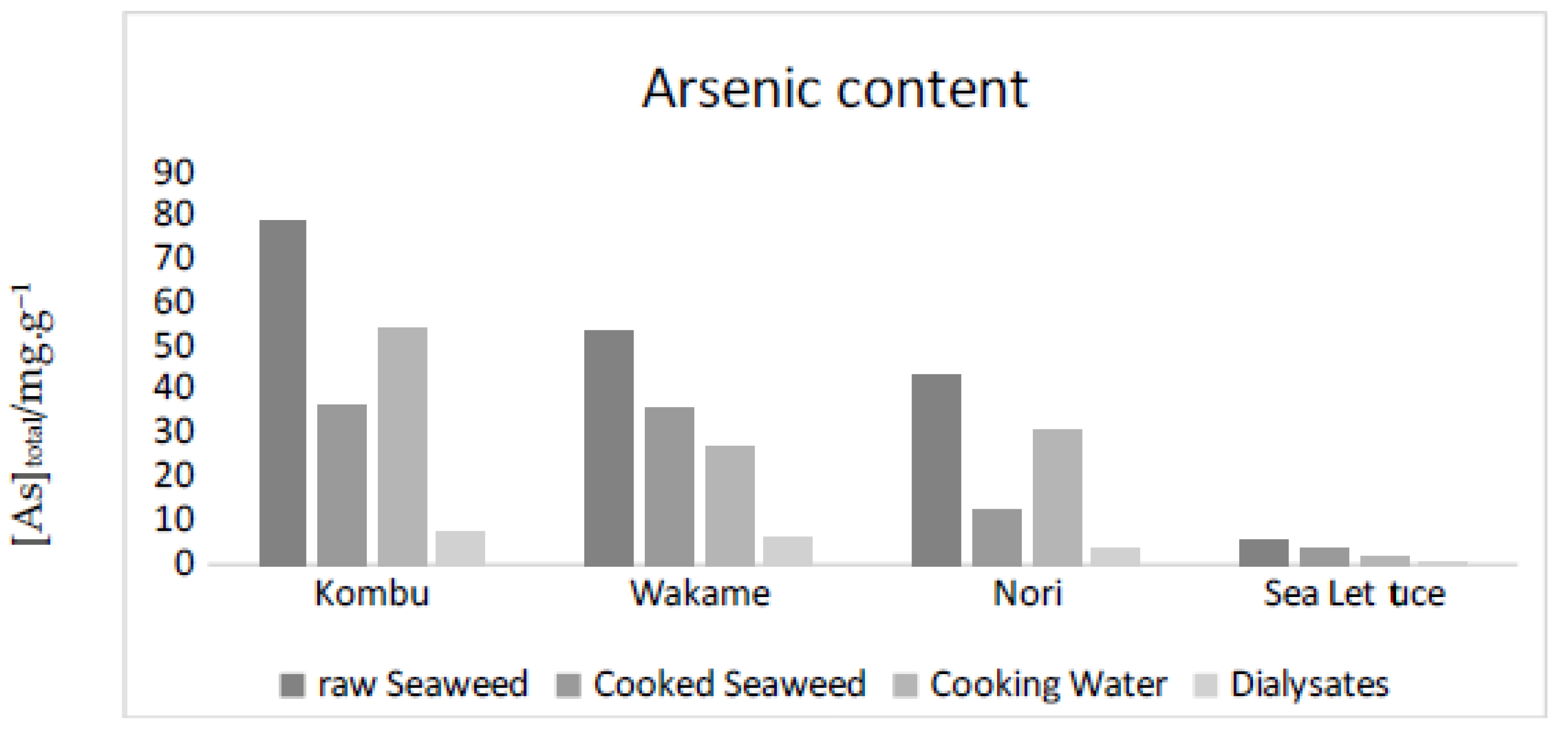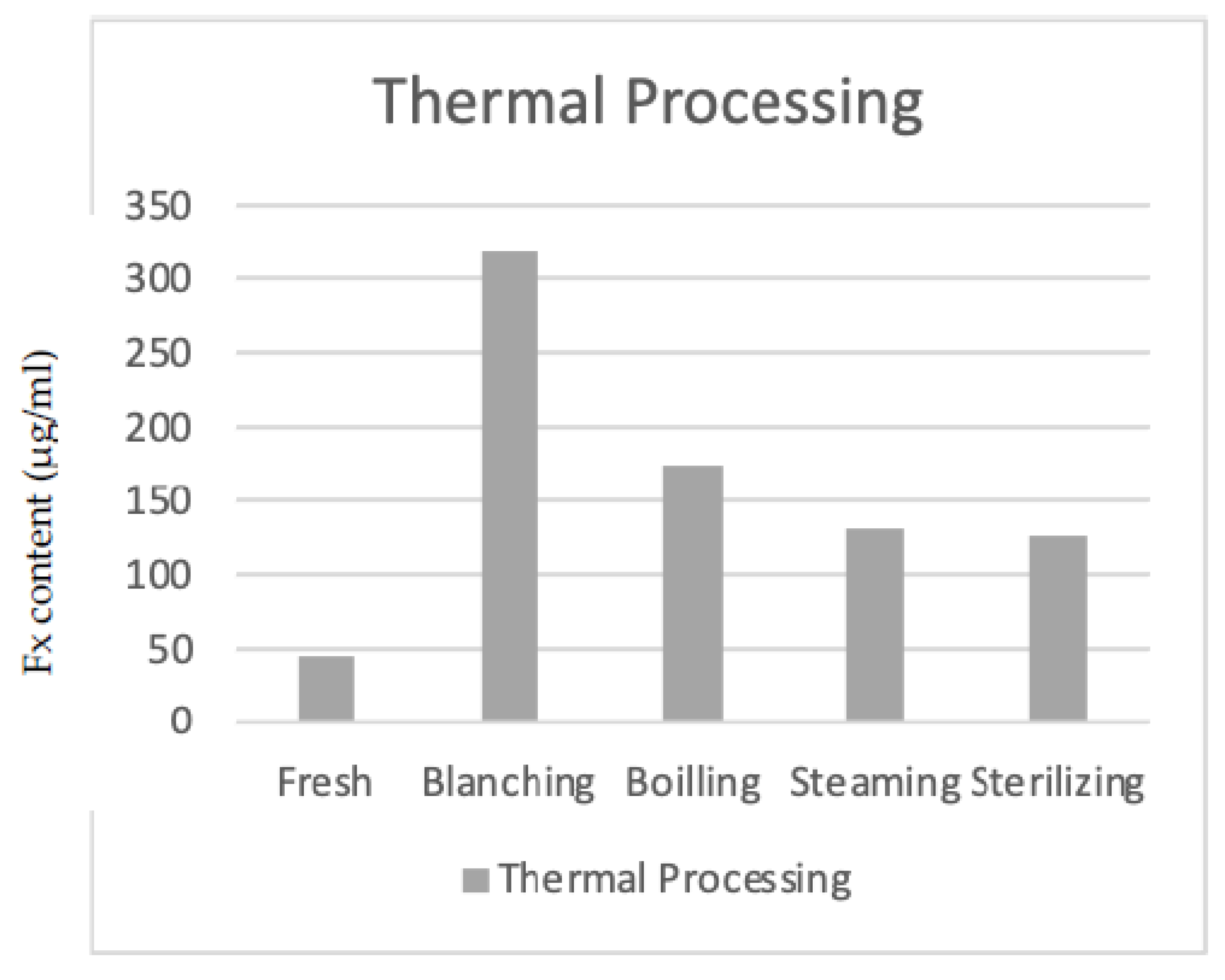Effects of Heat Treatment Processes: Health Benefits and Risks to the Consumer
Abstract
:1. Introduction
2. Moisture
3. Phenolic Content
4. Lipid Content
5. Rehydration and Cooking
6. Heat Treatment Influence on Chemical Structure
7. The Effect of Heat on Seaweed-Based Products
8. Problems of Heat Treatment Analyses and Approaches to Food Safety: A Future Road
9. Conclusions
Author Contributions
Funding
Institutional Review Board Statement
Informed Consent Statement
Data Availability Statement
Conflicts of Interest
References
- Geada, P.; Moreira, C.; Silva, M.; Nunes, R.; Madureira, L.; Rocha, C.M.R.; Pereira, R.N.; Vicente, A.A.; Teixeira, J.A. Algal Proteins: Production Strategies and Nutritional and Functional Properties. Bioresour. Technol. 2021, 332, 125125. [Google Scholar] [CrossRef]
- Dopelt, K.; Radon, P.; Davidovitch, N. Environmental Effects of the Livestock Industry: The Relationship between Knowledge, Attitudes, and Behavior among Students in Israel. Int. J. Environ. Res. Public Health 2019, 16, 1359. [Google Scholar] [CrossRef] [Green Version]
- Leandro, A.; Pacheco, D.; Cotas, J.; Marques, J.C.; Pereira, L.; Gonçalves, A.M.M. Seaweed’s Bioactive Candidate Compounds to Food Industry and Global Food Security. Life 2020, 10, 140. [Google Scholar] [CrossRef] [PubMed]
- Parodi, A.; Leip, A.; Slegers, P.M.; Ziegler, F.; Herrero, M.; Tuomisto, H.; Valin, H.; Commission, E.; Scientific, C.; Lucia, S.; et al. Future Foods: Towards a Sustainable and Healthy Diet for a Growing Population. Nat. Sustain. 2018, 1, 782–789. [Google Scholar] [CrossRef] [Green Version]
- Klnc, B.; Cirik, S.; Turan, G.; Tekogul, H.; Koru, E. Seaweeds for Food and Industrial Applications. In Food Industry; InTech: London, UK,, 2013. [Google Scholar]
- Shannon, E.; Abu-Ghannam, N. Seaweeds as Nutraceuticals for Health and Nutrition. Phycologia 2019, 58, 563–577. [Google Scholar] [CrossRef] [Green Version]
- Ferrara, L. Seaweeds: A Food for Our Future. J. Food Chem. Nanotechnol. 2020, 6, 56–64. [Google Scholar] [CrossRef]
- Alba, K.; Kontogiorgos, V. Seaweed Polysaccharides (Agar, Alginate Carrageenan). Encycl. Food Chem. 2018, 240–250. [Google Scholar] [CrossRef]
- Regal, A.L.; Alves, V.; Gomes, R.; Matos, J.; Bandarra, N.M.; Afonso, C.; Cardoso, C. Drying Process, Storage Conditions, and Time Alter the Biochemical Composition and Bioactivity of the Anti-Greenhouse Seaweed Asparagopsis taxiformis. Eur. Food Res. Technol. 2020, 246, 781–793. [Google Scholar] [CrossRef]
- Cox, S.; Gupta, S.; Abu-Ghannam, N. Effect of Different Rehydration Temperatures on the Moisture, Content of Phenolic Compounds, Antioxidant Capacity and Textural Properties of Edible Irish Brown Seaweed. LWT 2012, 47, 300–307. [Google Scholar]
- Badmus, U.O.; Taggart, M.A.; Boyd, K.G. The Effect of Different Drying Methods on Certain Nutritionally Important Chemical Constituents in Edible Brown Seaweeds. J. Appl. Phycol. 2019, 31, 3883–3897. [Google Scholar] [CrossRef] [Green Version]
- Susanto, E.; Fahmi, A.S.; Agustini, T.W.; Rosyadi, S.; Wardani, A.D. Effects of Different Heat Processing on Fucoxanthin, Antioxidant Activity and Colour of Indonesian Brown Seaweeds. IOP Conf. Ser. Earth Environ. Sci. 2017, 55, 012063. [Google Scholar] [CrossRef] [Green Version]
- Uribe, E.; Vega-Gálvez, A.; García, V.; Pastén, A.; Rodríguez, K.; López, J.; Scala, K. Di Evaluation of Physicochemical Composition and Bioactivity of a Red Seaweed (Pyropia orbicularis) as Affected by Different Drying Technologies. Dry. Technol. 2020, 38, 1218–1230. [Google Scholar] [CrossRef]
- Kane, S.N.; Mishra, A.; Dutta, A.K. Preface: International Conference on Recent Trends in Physics (ICRTP 2016). J. Phys. Conf. Ser. 2016, 755. [Google Scholar] [CrossRef]
- Sánchez-García, F.; Mirzayeva, A.; Roldán, A.; Castro, R.; Palacios, V.; G Barroso, C.; Durán-Guerrero, E. Effect of Different Cooking Methods on Sea Lettuce (Ulva rigida) Volatile Compounds and Sensory Properties. J. Sci. Food Agric. 2021, 101, 970–980. [Google Scholar] [CrossRef]
- Gupta, S.; Cox, S.; Abu-Ghannam, N. Effect of Different Drying Temperatures on the Moisture and Phytochemical Constituents of Edible Irish Brown Seaweed. LWT - Food Sci. Technol. 2011, 44, 1266–1272. [Google Scholar] [CrossRef] [Green Version]
- Dang, T.T.; Van Vuong, Q.; Schreider, M.J.; Bowyer, M.C.; Altena, I.A.V.; Scarlett, C.J. The Effects of Drying on Physico-Chemical Properties and Antioxidant Capacity of the Brown Alga (Hormosira banksii (Turner) Decaisne). J. Food Process. Preserv. 2017, 41, 1–11. [Google Scholar] [CrossRef]
- Silva, A.F.R.; Abreu, H.; Silva, A.M.S.; Cardoso, S.M. Effect of Oven-Drying on the Recovery of Valuable Compounds from Ulva rigida, Gracilaria sp. and Fucus vesiculosus. Mar. Drugs 2019, 17, 90. [Google Scholar] [CrossRef] [Green Version]
- Lage-Yusty, M.A.; Alvarado, G.; Ferraces-Casais, P.; López-Hernández, J. Modification of Bioactive Compounds in Dried Edible Seaweeds. Int. J. Food Sci. Technol. 2014, 49, 298–304. [Google Scholar] [CrossRef]
- Sappati, P.K.; Nayak, B.; VanWalsum, G.P.; Mulrey, O.T. Combined Effects of Seasonal Variation and Drying Methods on the Physicochemical Properties and Antioxidant Activity of Sugar Kelp (Saccharina latissima). J. Appl. Phycol. 2019, 31, 1311–1332. [Google Scholar] [CrossRef]
- Gallagher, J.A.; Turner, L.B.; Adams, J.M.M.; Barrento, S.; Dyer, P.W.; Theodorou, M.K. Species Variation in the Effects of Dewatering Treatment on Macroalgae. J. Appl. Phycol. 2018, 30, 2305–2316. [Google Scholar] [CrossRef] [PubMed] [Green Version]
- Nurshahida, M.S.F.; Aini, M.A.N.; Faizal, W.I.W.M.; Hamimi, I.A.; Nazikussabah, Z. Effect of Drying Methods on Nutrient Composition and Physicochemical Properties of Malaysian Seaweeds. AIP Conf. Proc. 2018, 2030, 1–5. [Google Scholar] [CrossRef]
- Marín B, E.; Lemus M, R.; Flores M, V.; Vega G, A. La Rehidratación De Alimentos Deshidratados. Rev. Chil. Nutr. 2006, 33. [Google Scholar] [CrossRef]
- Lee, K.T.; Farid, M.; Nguang, S.K. The Mathematical Modelling of the Rehydration Characteristics of Fruits. J. Food Eng. 2006, 72, 16–23. [Google Scholar] [CrossRef]
- Amin, I.; Norazaidah, Y.; Hainida, K.I.E. Antioxidant Activity and Phenolic Content of Raw and Blanched Amaranthus Species. Food Chem. 2006, 94, 47–52. [Google Scholar] [CrossRef]
- Shahidi, F. Nutraceuticals and Functional Foods: Whole versus Processed Foods. Trends Food Sci. Technol. 2009, 20, 376–387. [Google Scholar] [CrossRef]
- Mota, C.L.; Luciano, C.; Dias, A.; Barroca, M.J.; Guiné, R.P.F. Convective Drying of Onion: Kinetics and Nutritional Evaluation. Food Bioprod. Process. 2010, 88, 115–123. [Google Scholar] [CrossRef]
- Maskan, M. Drying, Shrinkage and Rehydration Characteristics of Kiwifruits during Hot Air and Microwave Drying. J. Food Eng. 2001, 48, 177–182. [Google Scholar] [CrossRef]
- Krokida, M.K.; Karathanos, V.T.; Maroulis, Z.B. Compression Analysis Of Dehydrated Agricultural Products. Dry. Technol. 2000, 18, 395–408. [Google Scholar] [CrossRef]
- Lewicki, P.P.; Jakubczyk, E. Effect of Hot Air Temperature on Mechanical Properties of Dried Apples. J. Food Eng. 2004, 64, 307–314. [Google Scholar] [CrossRef]
- García-Sartal, C.; del CarmenBarciela-Alonso, M.; Moreda-Piñeiro, A.; Bermejo-Barrera, P. Study of Cooking on the Bioavailability of As, Co, Cr, Cu, Fe, Ni, Se and Zn from Edible Seaweed. Microchem. J. 2013, 108, 92–99. [Google Scholar] [CrossRef]
- Olivera, D.F.; Viña, S.Z.; Marani, C.M.; Ferreyra, R.M.; Mugridge, A.; Chaves, A.R.; Mascheroni, R.H. Effect of Blanching on the Quality of Brussels Sprouts (Brassica oleracea L. Gemmifera DC) after Frozen Storage. J. Food Eng. 2008, 84, 148–155. [Google Scholar] [CrossRef]
- Rossi, M.; Giussani, E.; Morelli, R.; Lo Scalzo, R.; Nani, R.C.; Torreggiani, D. Effect of Fruit Blanching on Phenolics and Radical Scavenging Activity of Highbush Blueberry Juice. Food Res. Int. 2003, 36, 999–1005. [Google Scholar] [CrossRef]
- García-Pascual, P.; Sanjuán, N.; Melis, R.; Mulet, A. Morchella esculenta (Morel) Rehydration Process Modelling. J. Food Eng. 2006, 72, 346–353. [Google Scholar] [CrossRef]
- Amorim, K.; Lage-Yusty, M.-A.; López-Hernández, J. Changes in Bioactive Compounds Content and Antioxidant Activity of Seaweed after Cooking Processing. CyTA-J. Food 2012, 10, 321–324. [Google Scholar] [CrossRef] [Green Version]
- Maehre, H.K.; Edvinsen, G.K.; Eilertsen, K.-E.; Elvevoll, E.O. Heat Treatment Increases the Protein Bioaccessibility in the Red Seaweed Dulse (Palmaria palmata), but Not in the Brown Seaweed Winged Kelp (Alaria esculenta). J. Appl. Phycol. 2016, 28, 581–590. [Google Scholar] [CrossRef] [Green Version]
- Milinovic, J.; Rodrigues, C.; Diniz, M.; Noronha, J.P. Determination of Total Iodine Content in Edible Seaweeds: Application of Inductively Coupled Plasma-Atomic Emission Spectroscopy. Algal Res. 2021, 53, 102149. [Google Scholar] [CrossRef]
- Nielsen, C.W.; Holdt, S.L.; Sloth, J.J.; Marinho, G.S.; Sæther, M.; Funderud, J.; Rustad, T. Reducing the High Iodine Content of Saccharina latissima and Improving the Profile of Other Valuable Compounds by Water Blanching. Foods 2020, 9, 569. [Google Scholar] [CrossRef] [PubMed]
- García Sartal, C.; del CarmenBarciela-Alonso, M.; Bermejo-Barrera, P. Effect of the Cooking Procedure on the Arsenic Speciation in the Bioavailable (Dialyzable) Fraction from Seaweed. Microchem. J. 2012, 105, 65–71. [Google Scholar] [CrossRef]
- Rajauria, G.; Jaiswal, A.K.; Abu-Ghannam, N.; Gupta, S. Effect of Hydrothermal Processing on Colour, Antioxidant and Free Radical Scavenging Capacities of Edible Irish Brown Seaweeds. Food Sci. Technol. 2010, 45, 2485–2493. [Google Scholar] [CrossRef]
- Moreira Leite, B.S. Novas Alternativas Para o Uso de Macroalgas Da Costa Portuguesa Em Alimentação. Master’s Thesis, Universidade Nova de Lisboa, Lisboa, Portugal, 2017. [Google Scholar]
- Vucko, M.J.; Magnusson, M.; Kinley, R.D.; Villart, C.; de Nys, R. The Effects of Processing on the in Vitro Antimethanogenic Capacity and Concentration of Secondary Metabolites of Asparagopsis taxiformis. J. Appl. Phycol. 2017, 29, 1577–1586. [Google Scholar] [CrossRef]
- Banach, J.L.; Hoek-van den Hil, E.F.; Fels-Klerx, H.J. Food Safety Hazards in the European Seaweed Chain. Compr. Rev. Food Sci. Food Saf. 2020, 19, 332–364. [Google Scholar] [CrossRef]
- Nitschke, U.; Stengel, D.B. Quantification of Iodine Loss in Edible Irish Seaweeds during Processing. J. Appl. Phycol. 2016, 28, 3527–3533. [Google Scholar] [CrossRef]


Publisher’s Note: MDPI stays neutral with regard to jurisdictional claims in published maps and institutional affiliations. |
© 2021 by the authors. Licensee MDPI, Basel, Switzerland. This article is an open access article distributed under the terms and conditions of the Creative Commons Attribution (CC BY) license (https://creativecommons.org/licenses/by/4.0/).
Share and Cite
Cascais, M.; Monteiro, P.; Pacheco, D.; Cotas, J.; Pereira, L.; Marques, J.C.; Gonçalves, A.M.M. Effects of Heat Treatment Processes: Health Benefits and Risks to the Consumer. Appl. Sci. 2021, 11, 8740. https://doi.org/10.3390/app11188740
Cascais M, Monteiro P, Pacheco D, Cotas J, Pereira L, Marques JC, Gonçalves AMM. Effects of Heat Treatment Processes: Health Benefits and Risks to the Consumer. Applied Sciences. 2021; 11(18):8740. https://doi.org/10.3390/app11188740
Chicago/Turabian StyleCascais, Miguel, Pedro Monteiro, Diana Pacheco, João Cotas, Leonel Pereira, João Carlos Marques, and Ana M. M. Gonçalves. 2021. "Effects of Heat Treatment Processes: Health Benefits and Risks to the Consumer" Applied Sciences 11, no. 18: 8740. https://doi.org/10.3390/app11188740
APA StyleCascais, M., Monteiro, P., Pacheco, D., Cotas, J., Pereira, L., Marques, J. C., & Gonçalves, A. M. M. (2021). Effects of Heat Treatment Processes: Health Benefits and Risks to the Consumer. Applied Sciences, 11(18), 8740. https://doi.org/10.3390/app11188740








